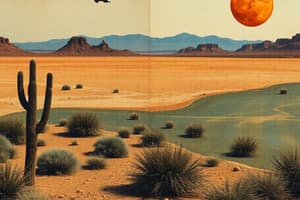Podcast
Questions and Answers
Explain how the lack of moisture in desert air contributes to the temperature fluctuations between day and night.
Explain how the lack of moisture in desert air contributes to the temperature fluctuations between day and night.
The lack of moisture in the air means there is less humidity. Humidity traps heat. Without that humidity, the desert heats up quickly during the day and cools down rapidly at night.
How does desert soil's composition affect plant growth, and what adaptations might plants develop to thrive in this environment?
How does desert soil's composition affect plant growth, and what adaptations might plants develop to thrive in this environment?
Desert soil is dry, sandy, and nutrient-poor, hindering plant growth. Adaptations include deep roots to reach water, water storage in stems/leaves, and tolerance to high temperatures.
Describe how the intensity of sunlight in the desert impacts both the temperature and the biological activity of desert organisms.
Describe how the intensity of sunlight in the desert impacts both the temperature and the biological activity of desert organisms.
Intense sunlight raises temperatures, affecting organism activity. It also supports photosynthesis in plants, which form the base of the desert food web.
Explain how the scarcity of water in the desert directly affects the life cycles and behaviors of desert organisms.
Explain how the scarcity of water in the desert directly affects the life cycles and behaviors of desert organisms.
Describe two ways that non-living elements of a desert ecosystem directly support the survival of living organisms.
Describe two ways that non-living elements of a desert ecosystem directly support the survival of living organisms.
Predict how a prolonged drought might alter the composition of a desert ecosystem, focusing on changes in both living and non-living components.
Predict how a prolonged drought might alter the composition of a desert ecosystem, focusing on changes in both living and non-living components.
Infer how the unique characteristics of desert air (low moisture, extreme temperature variations) influence the types of animals that can survive there.
Infer how the unique characteristics of desert air (low moisture, extreme temperature variations) influence the types of animals that can survive there.
In what ways do the non-living components of a desert ecosystem contribute to the overall biodiversity observed in that environment?
In what ways do the non-living components of a desert ecosystem contribute to the overall biodiversity observed in that environment?
How might the introduction of non-native plant species impact the existing balance between the non-living and living components of a desert ecosystem?
How might the introduction of non-native plant species impact the existing balance between the non-living and living components of a desert ecosystem?
Describe how temperature affects the lives of all living things.
Describe how temperature affects the lives of all living things.
Flashcards
Non-living desert elements
Non-living desert elements
Deserts contain non-living elements like sand, rocks, and sunlight that shape its landscape and create a dry, hot environment.
Desert air characteristics
Desert air characteristics
Desert air is typically hot and dry with minimal moisture, leading to large temperature differences between day and night. It provides carbon dioxide and oxygen.
Desert soil features
Desert soil features
Desert soil is usually dry and sandy with few nutrients, making it difficult for plant growth. It can be easily blown away by the wind, but it provides minerals.
Desert light conditions
Desert light conditions
Signup and view all the flashcards
Importance of water in deserts
Importance of water in deserts
Signup and view all the flashcards
Desert temperature variations
Desert temperature variations
Signup and view all the flashcards
Study Notes
- Deserts contain non-living elements like sand, rocks, and sunlight.
- These elements shape the desert landscape and create its dry, hot environment.
- There exist interactions between organisms and non-living components in deserts.
Air
- Desert air is typically hot and dry with minimal moisture.
- The low moisture levels intensify the heat during the day and cause cooler temperatures at night.
- Desert air provides carbon dioxide for plant photosynthesis and oxygen for all organisms.
Soil
- Desert soil is generally dry, sandy, and lacks moisture.
- It has few nutrients, making plant growth difficult.
- The soil is loose and easily blown away by wind.
- Rocks and soil supply minerals for plant growth and nesting materials for ground-nesting birds.
Light
- Desert sunlight is intense during the day, contributing to the desert's heat.
- Clear skies at night allow for stargazing and quick cooling due to minimal cloud cover.
- Sunlight aids plants in photosynthesis, producing food.
Water
- Water is vital in the desert, affecting all living organisms and the ecosystem.
- Organisms rely on water to keep their cells alive.
- When rain occurs, cells become more active, grow, and reproduce.
Temperature
- Desert temperatures fluctuate significantly between day and night.
- Daytime temperatures can exceed 38°C because of strong sunlight and dry air.
- The lack of clouds contributes to the heat.
- Night temperatures can drop close to freezing due to rapid cooling of the dry air after sunset.
Studying That Suits You
Use AI to generate personalized quizzes and flashcards to suit your learning preferences.




